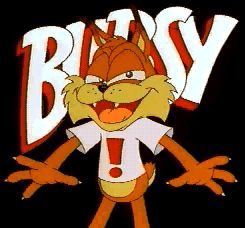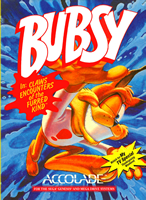Some say it started when a little Italian guy jumped up and down some ladders. Even though that created the start of the idea of a video game mascot, it wasn’t what, at least in my eyes, started the major need for every game company to suddenly create a  mascot. That honor would be reserved for Sonic The Hedgehog. Most of these characters created just didn’t work. Weather it be a cool character with a crappy game, or a good game with a dull character, they just never really clicked. A select few rose above the others. One of these is Bubsy the Bobcat, who graced the SNES and PSX, along of course with the Genesis.
mascot. That honor would be reserved for Sonic The Hedgehog. Most of these characters created just didn’t work. Weather it be a cool character with a crappy game, or a good game with a dull character, they just never really clicked. A select few rose above the others. One of these is Bubsy the Bobcat, who graced the SNES and PSX, along of course with the Genesis.
From programmer Mike Berlyn (Fooblitzky, Cutthroat) Bubsy used cartoon elements to make a memorable gaming experience. Bubsy was arguably the closest any characters gotten to achieve top mascot status. But that proverbial glass ceiling just came down on Bubsy, and the poor soul’s been gone for years. But what was it that did this to such a sure thing on paper? Why am I talking about him on a retro Sega site instead of writing a review of his newest game on Xbox? It’s something I’ve been pondering, and I’ve been able to figure out some basic points as to why he was never successful.
Developer History
Published by Accolade, the company that actually went to court with Sega over its reverse-engineering of the Genesis, Bubsy is the brainchild of Mike Berlyn. A veteran of the industry for almost two decades and one of the pioneers of the graphic adventure genre, Berlyn has been involved with several companies ranging from Infocom to Electronic Arts (where he produced a game for a group of college students who would eventually call themselves Naughty Dog) before landing at Accolade. There, he oversaw production on several graphic adventures, beginning with Search for the King and his own Altered Destiny. After Bubsy, Berlyn moved on to form Eidetec with former Infocom alumni Mark Blank, and the duo eventually reunited with Accolade for the third and last Bubsy game. A teacher and author, Berlyn keeps himself busy these days by marketing PC products, although he doesn’t discard one day returning to the industry he was instrumental in forming.
The Games
There were basic things a mascot needed to be successful in the video gaming world. Attitude is partially what made Sonic so popular; so Bubsy was made with a sort of smirk and various “rude” catchphrases. His eyelids were always slanted down, as if he didn’t really care about his next task; he was just having fun.
But a naked, smart-ass bobcat is nothing if he doesn’t have proper attire. Bubsy was fitted with nothing more than a white t-shirt with an exclamation point. Why? Who can say? The shirt wasn’t that usual for an animal to wear, or any other normal thing alive to wear either. It sure stood out though. When you sat and looked back on this character for the first time seeing it in a store, or on TV. Your interest was piqued. Who is this guy? What is his smirking about? Is he so cool that he can have the balls to smirk as if he’d already won, like Sonic? That shirt just looks so unusual. What does it mean? This game looks like it’s worth buying! I think we can say that the look (which brought along a failed TV pilot), although its oddness being a minor strike against it, can be overall seen as done well, and a positive influence on the buying public.
In all honesty, the Bubsy seems heavily based off of Sonic‘s basic engine of hold right and press jump every once in awhile. Bubsy improves on this by being more animated than Sonic, leaving a couple surprises in store for those you thought it was just the hedgehog in a shirt. The death animations alone do this, along with what unfortunately happens after hitting a wall.
 However, Bubsy hurts this engine by having the same problem that plagued plenty of platformers and is probably what kept him from becoming even bigger than he was: the jump and collision detection. With the one-hit-death rule, this was even worse than normal, especially when you were jumping on a somthing as gentle-looking as a bunny. If you were 1/10000th off the mark, you’d die. This drove many players away right there. The one-hit-death was also an annoyance when you hit a groove in a level and just start running. Before you knew it, you were crashing into a bad guy, losing another precious life to cheap death.
However, Bubsy hurts this engine by having the same problem that plagued plenty of platformers and is probably what kept him from becoming even bigger than he was: the jump and collision detection. With the one-hit-death rule, this was even worse than normal, especially when you were jumping on a somthing as gentle-looking as a bunny. If you were 1/10000th off the mark, you’d die. This drove many players away right there. The one-hit-death was also an annoyance when you hit a groove in a level and just start running. Before you knew it, you were crashing into a bad guy, losing another precious life to cheap death.
In Bubsy II, Accolade took many of the games problems and fixed them up to make the game somewhat more playable. A life gauge was implemented, in the way of Bubsys face. Doing away with the one-hit-death rule. Also, the hit detection was fixed, making the game much easier to play, and invited plenty of more casual gamers to play. Creative items were created: A Nerf gun for far away baddies, a bomb to clear the screen (or to fight a boss), a self contained underwater breathing apparatus (a.k.a Scuba Suit) to make water deaths a thing of the past. Also, a black hole to go back to the level select. The aforementioned level select also made the game more inviting; with more creative levels like a music world, and a space level with a pirate symbol (?). A 2-player mode allowed more to play, although the only real 2 player level that worked was the shooter levels, which were average. Bonus rounds were actually fun little mini-games, and helped you along the way. Some may say that even though this game was better, it wasn’t a full Bubsy game just because creator Mike Berlyn had since left Accolade.
Bubsy II received some press as picked up the slack from the first game and maybe reviving a lost cause. It had no input from Berlyn and was done entirely by another team. Needless to say, the final product fell far below expectations and compounded the first’s problems instead of fixing them. It was considered the worst of the series by fans and even Berlyn himself.
The series attempted a comeback on 32-bit consoles with Bubsy 3D, which strived to bring the bobcat into the n next generation. However, many agree that it just wasn’t fun to play, especially underwater. It was one of the first experiments into 3D platforming and had the unfortunate timing of releasing around the time of Super Mario 64. If Bubsy 3D had come out at another time, whether it be earlier or later, the game may have had better success.
What Went Wrong?
 Like I mentioned before, the market had plenty of mascot hopefuls released. Characters including: Aero the Acrobat, Chuck Rock, Earthwork Jim, Boogerman, Rocket Knight Adventures, and many others. Bubsy didn’t get lost in the mix like some other games did, but was unfortunately held back simply because it was compared to Sonic and Super Mario Bros., and just categorized with the other mascot platformers of the era. While Bubsy is a rare exception in that it received two sequels, it still never really picked up steam enough to stand out. The consequences of this affected more than just Bubsy. Plenty of games in the works were stopped by sub par sales. Also, this was a time when plenty of other games in the genre were released in 3D that were simply more popular and played better. Bubsy just didn’t have a real chance. Mascots have always existed since though, and seem to have had a revival as of late, with games like Tak, Jax & Daxter, Ratchet & Clank, etc.
Like I mentioned before, the market had plenty of mascot hopefuls released. Characters including: Aero the Acrobat, Chuck Rock, Earthwork Jim, Boogerman, Rocket Knight Adventures, and many others. Bubsy didn’t get lost in the mix like some other games did, but was unfortunately held back simply because it was compared to Sonic and Super Mario Bros., and just categorized with the other mascot platformers of the era. While Bubsy is a rare exception in that it received two sequels, it still never really picked up steam enough to stand out. The consequences of this affected more than just Bubsy. Plenty of games in the works were stopped by sub par sales. Also, this was a time when plenty of other games in the genre were released in 3D that were simply more popular and played better. Bubsy just didn’t have a real chance. Mascots have always existed since though, and seem to have had a revival as of late, with games like Tak, Jax & Daxter, Ratchet & Clank, etc.
There’s not much more you can say about our little friend here. He was created to make money, but he did more than that. He became a bit of a cult classic. Fans will admit the game wasn’t the best platformer out there, but there was just something about him. Weather it’s the smirk, those coy eyes, the exclamation mark shirt, or the fact that he wore no shoes; he just stuck. Unfortunately for him, he didn’t stick at the right time.
The complete release chronology is as follows:
- Bubsy in Claws Encounters of the Furred Kind, Genesis (1993)
- Bubsy in Claws Encounters of the Furred Kind, SNES (1993)
- Super Bubsy, Windows PC (1994)
- Bubsy in Fractured Furry Tales, Atari Jaguar (1994)
- Bubsy II, Genesis (1994)
- Bubsy II, SNES (1994)
- Bubsy II, Game Boy (1994)
- Bubsy 3D: Furbitten Planet, Sony Playstation (1996)

Recent Comments